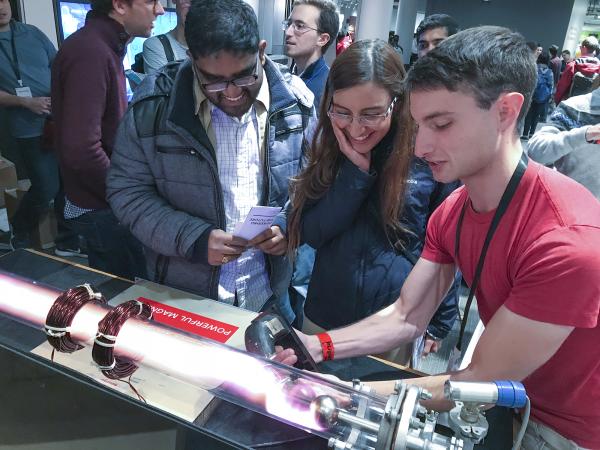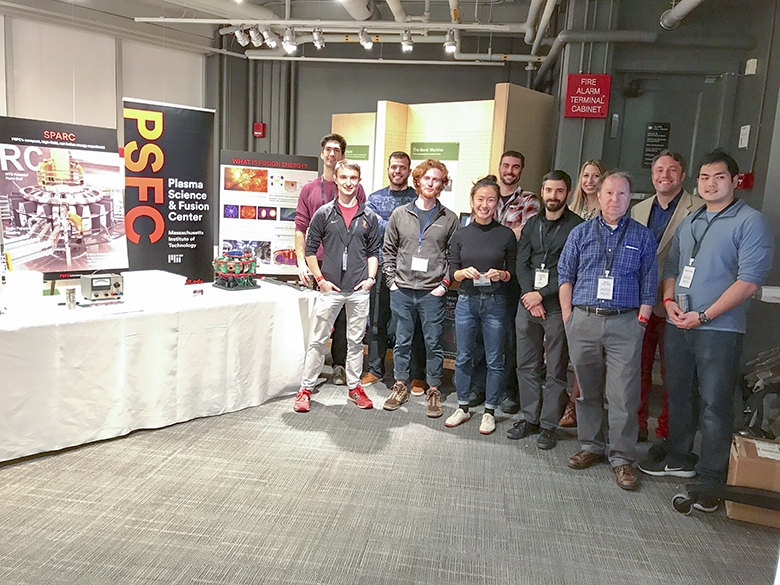
At MIT Energy Night, graduate student Alex Creely demonstrates how a magnet affects a glowing plasma, the basis of magnetic confinement fusion.
Paul Rivenberg
PSFC and CFS demonstrate the science behind tokamak research
October 31, 2018
Liquid nitrogen flowed and plasma glowed at MIT’s Energy Night as Plasma Science and Fusion Center (PSFC) graduate students demonstrated how fusion happens, and how MIT is working with a new superconducting technology to make It happen sooner at less cost.
Stationed on the MIT Museum’s first floor, the PSFC presented a series of demonstrations geared to introduce plasma and fusion to the general public. Alex Creely and Francesco Sciortino created fuchsia-colored plasma in a vacuum tube to show how this so-called “fourth state of matter” responds to magnetic fields, a property that allows researchers to confine it within the donut-shaped chamber of a tokamak.
Nearby, Erica Salazar, Theo Mouratidis, Sean Ballinger and Adam Kuang took turns using liquid nitrogen to demonstrate the principles of superconductivity, the scientific foundation of a new, thin high-temperature superconducting (HTS) tape. In collaboration with Commonwealth Fusion Systems (CFS), the PSFC is using this tape to develop strong magnets for SPARC, a compact and powerful fusion experiment. Representatives of CFS were also on hand to discuss a vision for the future of fusion.
 Energy Night volunteers from the PSFC and CFS included (left to right) Sean Ballinger, Alex Creely, Theo Mouratidis, Alex Tinguely, Ching Tse, Brandon Sorbom, Ted Golfinopoulos, Gabrielle Downey, Martin Greenwald, Tyler Ellis and Adam Kuang.
Energy Night volunteers from the PSFC and CFS included (left to right) Sean Ballinger, Alex Creely, Theo Mouratidis, Alex Tinguely, Ching Tse, Brandon Sorbom, Ted Golfinopoulos, Gabrielle Downey, Martin Greenwald, Tyler Ellis and Adam Kuang.
During two 10-minute “lightning talks” promoted by Energy Night, the exhibitors provided a brief but comprehensive overview of plasma, fusion, superconductivity, and the genesis of SPARC.
Manning a large monitor, graduate student Alex Tinguely provided a 3D tour of the PSFC’s most recent fusion experiment, Alcator C-Mod, which continues to support important research.
“People were mostly interested in the fact that C-Mod is only located about 2 blocks from the MIT Museum on MIT's campus,” he noted. “I think they were just amazed that a tiny star was being made nearby at MIT.”
With its prime location and featured talks, the booth was popular with the evening’s attendees, which numbered over 1000.
Brandon Sorbom, an MIT graduate who is cofounder and chief science officer of CFS, was pleased with the response to the potential of fusion energy.
“The excitement in the crowd was palpable,” he said. “You always know you're doing something right when people have to wait in line for a chance to see the demos!”
Topics: Magnetic fusion energy, SPARC, High field magnets, Martin Greenwald